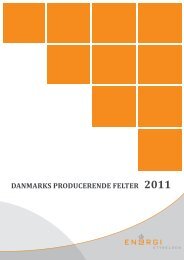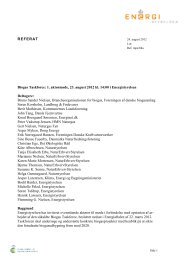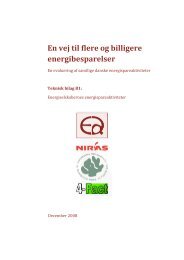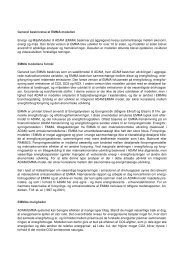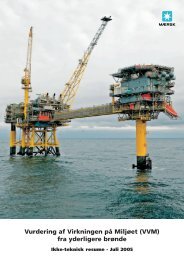Energy Strategy 2050 – from coal, oil and gas
Energy Strategy 2050 – from coal, oil and gas
Energy Strategy 2050 – from coal, oil and gas
You also want an ePaper? Increase the reach of your titles
YUMPU automatically turns print PDFs into web optimized ePapers that Google loves.
Efforts for greenhouse <strong>gas</strong> reductions made until now<br />
have laid the foundation for compliance with the reduction<br />
commitment. A number of the government initiatives<br />
to reduce fossil fuel use will also lead to significant<br />
reductions in the non-ETS sectors. All in all, it has been<br />
estimated, that the government’s new initiatives will<br />
reduce non-ETS emissions by 4-5 million tonnes CO2<br />
equivalents in the period 2013-2020. The greatest effect<br />
will be achieved <strong>from</strong> enhanced efforts to improve energy<br />
efficiency. In addition, effects will also be achieved<br />
by conversion away <strong>from</strong> individual heating based on <strong>oil</strong><br />
<strong>and</strong> <strong>gas</strong>, a greater share of biofuels, an improved framework<br />
for using bio<strong>gas</strong> <strong>and</strong> free choice of fuel.<br />
This will allow for a flexible <strong>and</strong> dynamic choice of further<br />
climate initiatives in sectors such as agriculture, waste<br />
<strong>and</strong> transport. The government will follow up on efforts<br />
regularly to ensure compliance with the 2020 climate<br />
commitment, <strong>and</strong> launch new initiatives as required.<br />
Significant greenhouse <strong>gas</strong><br />
reductions in the long term<br />
The need for significant reductions with regard to total<br />
greenhouse <strong>gas</strong> emissions in the long term also requires<br />
that the right foundation is laid down early in the process.<br />
Thus short term efforts will contribute to steering<br />
Denmark in the right direction with regard to the common<br />
EU objective of an 80%-95% reduction by <strong>2050</strong><br />
relative to 1990. Even though the EU target cannot be<br />
translated into a Danish reduction commitment, it gives<br />
an impression of the challenge facing Denmark with<br />
regard to long term reductions.<br />
Total greenhouse <strong>gas</strong> emissions will be<br />
further reduced in line with the phase<br />
out of fossil fuels.<br />
Total greenhouse <strong>gas</strong> emissions will be further reduced<br />
in line with the phasing out of fossil fuels. Calculations<br />
made by the Danish Commission on Climate Change<br />
Policy show that when Denmark’s energy <strong>and</strong> transport<br />
systems no longer use fossil fuels, <strong>and</strong> therefore have<br />
more or less no carbon emissions, Denmark’s greenhouse<br />
<strong>gas</strong> emissions will be reduced by approximately<br />
75%. Thus Denmark will be able to contribute to meeting<br />
the EU objective, as well as the objective to limit the average<br />
temperature rise to 2°C, as agreed in Copenhagen<br />
in 2009 <strong>and</strong> in Cancún in 2010. However, cost-effective<br />
reduction of total emissions requires efforts to limit<br />
greenhouse <strong>gas</strong> emissions outside the energy sector,<br />
both CO2 <strong>and</strong> other greenhouse <strong>gas</strong>es, see figure 4.12.<br />
mill tonnes CO2 eq.<br />
80<br />
70<br />
60<br />
50<br />
40<br />
30<br />
20<br />
10<br />
0<br />
1990 2008 2020 <strong>2050</strong><br />
Other Agricultural CO2 <strong>from</strong> fossil fuels<br />
Figure 4.12. Denmark’s greenhouse <strong>gas</strong> emissions in 1990,<br />
2008, 2020 <strong>and</strong> <strong>2050</strong> (adj. emissions, excluding carbon<br />
storage). Source: Danish <strong>Energy</strong> Agency/Danish Commission on Climate<br />
Change Policy (<strong>2050</strong>-scenario)<br />
<strong>Energy</strong> <strong>Strategy</strong> <strong>2050</strong> <strong>–</strong> <strong>from</strong> <strong>coal</strong>, <strong>oil</strong> <strong>and</strong> <strong>gas</strong> to green energy.<br />
53




